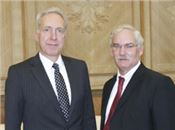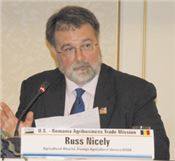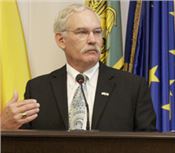|
Trade Abroad

Pictured on the left is Ambassador to Romania since September 2015,
Hans G. Klemm, visiting with Acting Deputy Secretary Michael Scuse.
Photos by John LaRose
Forged Friendships Bring Rewards To U.S., Romania
6th of a 10 Part Series
JOHN M. LAROSE
BETTY VALLE GEGG-NAEGER
MidAmerica Farmer Grower
BUCHAREST, ROMANIA
Romanian farming lifestyle and their struggle to modernize their agriculture systems and agriculture trade and investment opportunities were topics at a briefing given to the USDA Trade Mission visiting Romania recently. Led by USDA Acting Deputy Secretary (ADS) Michael Scuse the group included five State Departments of Agriculture and eight U.S. agriculture organization and agribusinesses.
The briefing was presented by Hans G. Klemm, U.S. Ambassador to Romania; Michael P. Stewart, Economic Counselor at the U.S. Embassy in Bucharest and Russ Nicely, Regional Agriculture Attaché for USDA Foreign Agriculture Service in Eastern Europe headquartered in Warsaw, Poland.
Hans G. Klemm, U.S. Ambassador to Romania since September 2015 led the briefing. “One of our priorities within the U.S. Romania framework is to try to strengthen the prosperity of both of our economies,” Klemm began. “Romanian leaders have asked me to place more focus on the economic dimension of our relationship and one thing that I want to do is find ways to increase trade in goods, services and investment between our two countries. So I was very grateful that ADS Scuse and his large team were willing to come to Romania and lead this delegation to explore opportunities for additional trade in agricultural goods and services and potential investment between our two countries,” stated Klemm.
Michael Stewart stated that, “Romania has a total population of 20 million people and 45 percent are generally on the farm. It is reported that 40 percent of agricultural land is owned by foreigners. I’m not sure if that’s true or not but that is the perception. The prevalent fear among farmers is that Romanians are losing their lands, their traditional agricultural lifestyle.”
“The country has no effective agricultural extension service. Also, there’s no effective government presence in the rural areas bringing farmers together and helping them access markets,” stated Stewart.

Russ Nicely, Regional Agriculture Attaché for USDA Foreign Agriculture Service
in Eastern Europe headquartered in Warsaw, Poland.
Russ Nicely, said the average farm size in Romania is 20 hectares or about 49.4 acres. The average commercial farm is 207 hectares, or 511.29 acres. Nicely commented on the soil conditions in Romania, “It’s a very rich soil, it’s not the standard of Iowa in our great Midwest, but it is quite productive. Farmers don’t utilize fertilizer on a large scale because that is cost prohibitive.”
“You will see horse carts and animal-drawn equipment today in parts of the country like our great-grandfathers farmed in America years ago,” Nicely said. “They’re still doing it here. The good news is they have sections of the country where you might think you’re in Iowa. But that’s not the standard, it’s not the norm. Yet they have wonderful soil so they do have great potential to do more. The biggest problem is they don’t have access to loans to increase their mechanization and buy higher grade inputs. So these are low input operations mainly and there’s a lot of physical work.”
“Romania has 3.6 million farmers, the most in Europe. Often these are family-run farms, and 40 percent of the workforce is involved in the total Ag economy. Agricultural production is the major source of income for households from rural areas. Like in America, the young people are looking to the big lights of the city in hopes of a better life.”
“Farming here is very inefficient and under mechanized and what they do produce is generally the underpinnings of the wealth of the country,” said Nicely. “They’ve been doing this a very long time. Their wine industry predates the Romans, which is an extraordinarily long time. They have been doing Ag trade forever, essentially. They have the Danube River on the southern border of the country and it’s a major corridor. I think one of the reasons the Romans came to this part of the world is the ability to produce grain. They coveted the land and that’s how this area was named Romania. However, agricultural resources were behind their interests.”
Romania’s agricultural trade was created mostly with the EU, Netherlands, Germany, the UK and Italy.
“We were their 10th largest supplier the past year and we’ve been moving up over the years. Our relationship is growing and is becoming increasingly intertwined,” Nicely said.
“Grain storage is an issue here, where they’re using a lot of traditional methods. They just don’t have the money to buy good grain bins and equipment. However the commercial farms are more modern, more mechanized. Some look up to speed on an international scale, but actually they are not large in size and not many in numbers, so the scale of operation is different,” he added.
“Transportation is also sub-scale. They have decent two-lane roads and they move their equipment around with small tractors, not at all comparable to the big ones in the Great Plains of the United States.”
“They have some good operations, but it’s a low capital industry relative to farms in the states. There’s a huge difference, it’s more sweat and less money,” Nicely asserted.
“Irrigation would take deeper pockets to fund, so that’s almost non-existent now. They have made some proposals to the EU for funding for irrigation and are having some difficulty getting them administered. There are some big plans out there for large scale irrigation systems off of the Danube river systems with EU funding, but the plans have not progressed.”
“Yesterday we heard that the government is not as strong as it could be, so their efforts to develop some programs with the EU have taken more time,” said Nicely. “They’ve had some changes in their government, so things change, priorities change, and they could greatly benefit from irrigation.”
“This is a hot and dry continental climate. It’s mostly rain-fed agriculture now, they have some great river systems and mountains so they do benefit from runoff, but the problem is climate change is hitting everyone especially hard here.”
Nicely said “the Vice Rector for the Ag University told him some horticulture production does draw on some deep wells, so they do have limited well-fed irrigation, but that’s not the norm.”
He called agricultural trade with the United States “one of the hottest growing markets in the EU. It has a projected average of 3.5 percent GDP for the next 15 years. “While that number is not so spectacular, it’s steady and consistent and it’s been proven,” Nicely said. “We see consumers upgrading what they buy to eat and they’re buying more expensive things than in the past, because now they can afford them. They’re adding more meat to their diets, using it more often than just for special meals. Romanians are spending about 20 percent more in food and retail supplies, which shows their situation is improving, they have more disposable income. They now have extra funds, they see something they want and that’s really nice for us. The share of consumer expenditures for food is high in Romania, more than 40 percent, three times larger than the EU average.
“Their number of food retailing stores reached 1,600 with about 55 percent of those modern supermarkets. That’s up from a few years ago, it’s tripled three times. This market is interested in everything we have.”
“The nice thing is their growth in the retail area is 7 percent now, compared to 1 percent in the EU. It’s smaller than in Germany or France, but it’s quite important and this is really the place, they’re receptive to us.”
“Obviously, products have to be labeled properly and packaged acceptable to the customers. Anyone thinking of exporting should start small and build a relationship. These people like American products.”
“Romania is both an importer and exporter of agricultural products. They import a fair amount of things from planting seeds to vegetables and fruits, and they export as well. It’s a great example of comparative advantage,” Nicely explained. “The United States is known as a corn producer, but they sold markets in the U.S. almost $1 hundred million dollars’ worth of corn products last year. This was good organic-type corn for some of our folks who couldn’t find what they were looking for in the states. I can’t find a better example of breaking barriers to promote international trade.” Everyone sees the U.S. as the world’s main corn producer, so they ask “why we would want to buy corn?”
“This is a textbook case for the comparative benefits of international trade,” said Nicely. “We sell them a lot of planting seeds, they buy a lot of planting seeds. They are blessed with fertile lands. They’re in the EU, but their infrastructure is not as robust as those in the western part of the EU. The cost of transport is an impediment to trading with a lot of communities. However, they have a great, deep water port complex out on the Black Sea so they can get their product in and out to market and they’ve done so for eons. They produce a wide range of agricultural products. They’re best known for their bulk commodities, wheat, barley, rapeseed, corn and sunflower in particular. “However, part of the problem is they have mostly small farms, they’re fragmented, and they have small yields, one of the lowest in the EU. This is due to a number of problems: low irrigation; dryer, hotter continental climate; low mechanization; low access to financial resources and fragmented plots.”
“So trade can work both ways,” he continued. “I think the long term benefit we can get from this market is providing them with improved genetics, seeds and technologies to increase their ability on the bulk end. Then, they are also consumers, they have money to spend so they’ll buy the packaged products and they like to try American products. We’re doing a great business with our distilled spirits which are very popular here. Some imports are comprised of further processed products, however, there is just about room for anything if you find the right partner.”
“Romanian importers are generally looking at the United States as a reliable source of well-known brands and high-end products. They usually prefer products with six months’ shelf-life or more. In addition to the product itself, packaging implies status, and innovation is also an important attribute. Products that combine these characteristics are more likely to enter the market. The food categories that are most exported to Romania from the United States are tree nuts, fish and seafood, and pet food.
Nicely said the Trade Mission sends a message that the United States is very serious about their market.”
“It is one of the stronger economies in the EU and it looks like it’s going to maintain its growth rate,” he said. Romania’s economy continued its growth pattern, reaching a growth rate of 3.7 percent in 2015, after a level of 2.9 percent for 2014. This is one of the highest growth rates within the EU.”
“One sour note is how countries struggle to hold their market specifically for their own agricultural sector. In Romania they just passed a few amendments to their retail food law that requires that 51 percent of food products sold in retail chains in the categories of beef, eggs, fruits, vegetables, honey, dairy and baked goods must be locally produced. The legal process to implement this will take about eight months, and the retailers association is vigorously protesting this. I think it could be a violation of the WTO agreement; you can’t differentiate on this,” Nicely said. “I don’t know the technicalities behind it, but I think it can be pursued.”
“So basically, to sum up, this country has resources, it has rich land, and it has eager young consumers who are moving up the economic ladder. It’s a great place to be right now and I think it’s only going to get better. As we look at the world, there’s not a lot of hot economies, and this is one of them,” Nicely summed. ∆
JOHN M. LAROSE: Publisher MidAmerica Farmer Grower
BETTY VALLE GEGG-NAEGER: Senior Staff Writer, MidAmerica Farmer Grower
Editor’s Note: Watch for the last articles about the agriculture industry of Ukraine and Romania. Next week: Ukraine May Become World’s Largest Grain Exporter In 10 To 15 Years; Bunge Marks Completion Of Ukraine Port Facility Annex and U.S. Rice May Find Niche Market In Ukraine, Romania.

ADS Scuse speaking during a Roundtable Discussion with
faculty and students at the University of Agricultural Science and Veterinary
Medicine in Marasti.

Faculty and students at a Roundtable Discussion with the University of
Agricultural Science and Veterinary Medicine in Marasti.
|
|